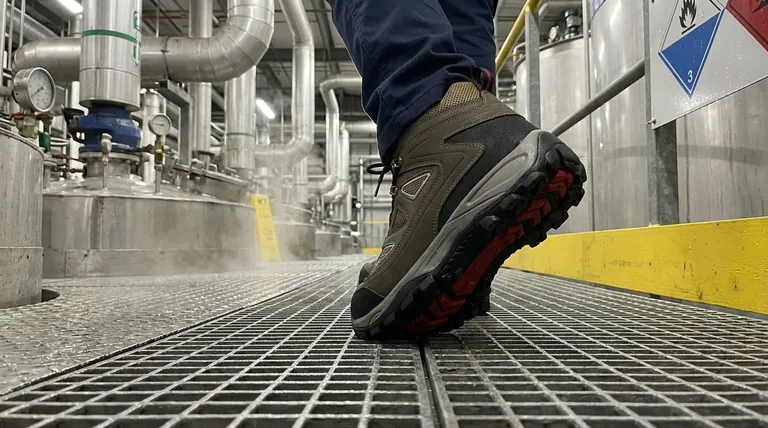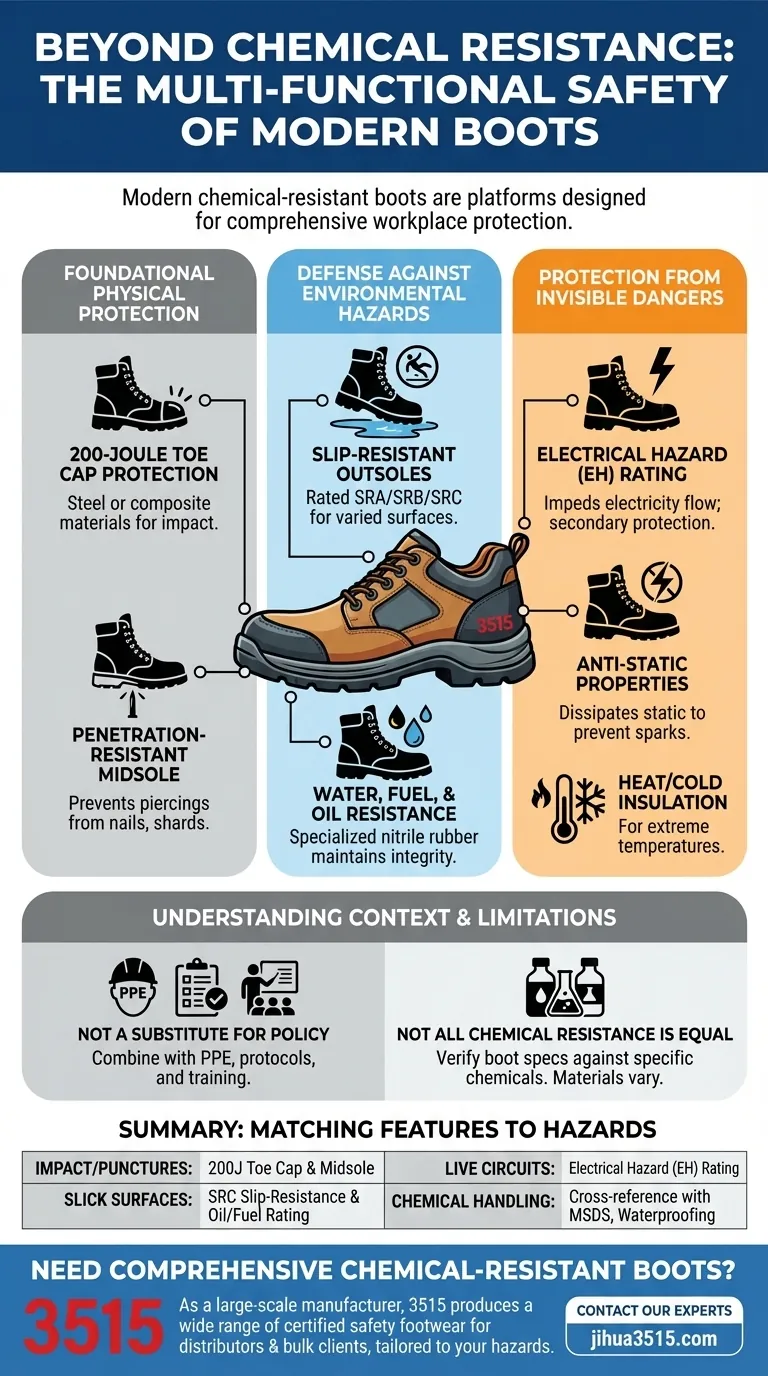Beyond their primary purpose, modern chemical-resistant boots are multi-functional platforms designed to counter a wide range of workplace dangers. They frequently integrate critical safety features such as certified toe protection, slip-resistant outsoles, penetration-resistant midsoles, and protection from electrical hazards to provide comprehensive safety.
The key is to view chemical resistance not as a standalone feature, but as one essential layer of protection in a boot that must be matched to the full spectrum of hazards present in your specific work environment.

A Deeper Look at Integrated Safety Features
A boot's effectiveness comes from its ability to protect against multiple, often overlapping, risks. While chemical resistance is the headline feature, the underlying protective technologies are what ensure all-around safety on the job.
Foundational Physical Protection
The most fundamental safety features address direct physical threats. Most high-quality safety boots, including chemical-resistant models, offer 200-joule toe cap protection, which can be made from steel or lighter composite materials.
Additionally, a penetration-resistant midsole is crucial in environments where sharp objects like nails or metal shards are underfoot. This feature prevents objects from piercing the sole and injuring the foot.
Defense Against Environmental Hazards
Work environments are rarely clean or dry. High-grade slip resistance is a critical feature, with soles often rated SRA (tested on ceramic tile with soap), SRB (tested on steel with glycerol), or SRC (tested for both).
Many boots also provide resistance to water, fuel, and oil, ensuring the boot's integrity and grip are not compromised by common industrial liquids. This is often achieved with specialized rubber nitrile outsoles.
Protection from Invisible Dangers
Some of the most serious risks cannot be seen. Boots with an Electrical Hazard (EH) rating are designed to impede the flow of electricity, offering a secondary source of protection against accidental contact with live electrical circuits.
Conversely, anti-static properties are designed to dissipate static electricity safely, which is critical in environments where a static spark could ignite flammable materials or damage sensitive electronic equipment. Other features include heat or cold insulation for extreme temperature work.
Understanding the Limitations and Context
Selecting the right boot requires acknowledging that no single piece of equipment is a complete solution. Understanding the context of its use is as important as understanding its features.
A Boot is Not a Substitute for Policy
Even the most advanced footwear is only one component of a larger safety system. Its protection is only realized when combined with proper Personal Protective Equipment (PPE), strict adherence to safety protocols, and regular employee training on hazard awareness.
Not All Chemical Resistance is Equal
The term "chemical resistant" is broad. Some boots may use caustic-resistant leather tested against specific substances like Sodium Hydroxide or Sulphuric Acid, while others use polyurethane for protection against mild splashes.
It is absolutely critical to verify the boot's resistance specifications against the specific chemicals you handle. A boot effective against acids may offer little protection against powerful solvents.
Making the Right Choice for Your Goal
To select the correct footwear, you must first perform a thorough risk assessment of your work environment. Then, match the boot's certified features to those specific hazards.
- If your primary focus is impact and punctures: Prioritize a certified 200-joule toe cap and a penetration-resistant midsole.
- If your primary focus is stability on slick surfaces: Insist on a sole with a high slip-resistance rating (SRC) and confirm it is also rated for oil and fuel resistance.
- If your primary focus is working near live circuits: Ensure the boot carries a specific Electrical Hazard (EH) rating.
- If your primary focus is direct chemical handling: Cross-reference the boot's material data sheet with the specific chemicals used on-site and consider features like waterproofing for full protection.
Ultimately, the safest choice is the one that comprehensively addresses every potential hazard in your specific work environment.
Summary Table:
| Feature Category | Key Safety Features | Purpose |
|---|---|---|
| Foundational Protection | 200-Joule Toe Cap, Penetration-Resistant Midsole | Protects against impacts and punctures from sharp objects. |
| Environmental Defense | Slip-Resistant Outsoles (SRA/SRB/SRC), Oil/Fuel Resistance | Prevents slips and falls on wet or oily surfaces. |
| Invisible Hazard Protection | Electrical Hazard (EH) Rating, Anti-Static Properties | Mitigates risks from live circuits and static discharge. |
Need chemical-resistant boots with comprehensive safety features?
As a large-scale manufacturer, 3515 produces a comprehensive range of safety footwear for distributors, brand owners, and bulk clients. Our production capabilities encompass all types of chemical-resistant boots and work shoes, integrating the critical protections you need—from certified toe caps and slip-resistant soles to EH ratings—tailored to your specific workplace hazards.
Let us help you equip your team with the right protection. Contact our experts today for a consultation and to discuss your requirements.
Visual Guide

Related Products
- Safety Footwear Wholesale Manufacturer for Custom OEM/ODM Production
- Premium Wholesale Waterproof Safety Boots High Performance Protection for Industrial Markets
- Wholesale Safety Footwear Manufacturer for Bulk & Custom OEM Orders
- Customizable Anti-Smash Safety Boots for Wholesale & Private Label Manufacturing
- Custom Wholesale Leather Safety Boots Direct Factory Manufacturing
People Also Ask
- What do heavy duty boots do? Protect Your Feet in Demanding Work Environments
- What cultural and environmental considerations are tied to wearing shoes indoors? Balance Hygiene, Tradition, and Foot Health
- Is it normal to wear shoes in the house? A Guide to Hygiene, Comfort & Culture
- What are the cultural perspectives on wearing shoes in the house? A Guide to Home Etiquette & Hygiene
- Do snake bite boots work? Your Ultimate Guide to Effective Snake Bite Protection



















